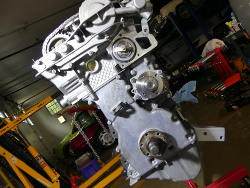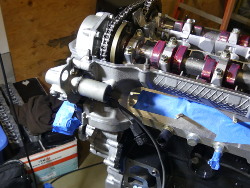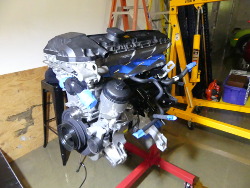Saturday, October 14, 2017
Rotation Test
The first thing I did today was rotate the crank. This sounds like such a simple thing to do, but I considered it an essential test at this phase in the build. It ensured two things:
-
The head installation and engine timing procedures did not cause anything to bind.
-
There are no obvious clearance issues between the pistons and valves.
Having built the bottom end of the engine I had a pretty good sense of the resistance provided by the crank plus that of the rear main seal. I also pulled the crank through more than a few times after I installed the pistons and rods and figured out the effort required. But this was to be the first time I tried to rotate the entire engine so I didn't know what to expect.
When ready I removed the timing blocks from the cams and hung my 22mm socket and ratchet on the crank bolt. I could have used a breaker bar here but I intentionally used something with a short handle to make it more difficult to apply a lot of torque, and in the process increase my sensitivity to any sudden change in resistance. I found the engine initially hard to turn, but after a mere 20 or 30 degrees of rotation I felt the resistance increase dramatically so I stopped. After I cleared the lump in my throat I thought about it for a few seconds, at which point the cause dawned on me -- the plugs were installed and I was fighting compression.
After I removed the plugs I found the resistance was much lower and far more linear. The good news is that I managed to pull the crank through a full 720 degrees of rotation while watching the cams rotate exactly once to return to the TDC position, and I felt no sudden increase in resistance that may have implied contact between the pistons and valves.
I double checked the marks I made on the rear main seal and crank flange when the flywheel had been used in conjunction with the TDC locking pin to place the bottom end at TDC, and found they were closely aligned. Later, when I installed the crank damper and A/C pulley, I gained access to another TDC reference (the factory marks on the damper and timing cover) and found those only slightly misaligned. This was understandable given that it is impossible to tell exactly where TDC is by looking at the cams alone. Once I corrected that the marks on the rear main seal lined up perfectly as well. So the engine appears timed correctly and ready for first start.
Final Assembly
With the rotation test complete I was able to do the final assembly of the engine in prep for delivery to my technician. I have to admit this was a refreshing change from the "do it correctly the first time or else" mentality I've had to cultivate over the last several weeks. I won't bore you with all the details, as much of the related work has been discussed elsewhere on the site, but I'll provide some highlights:
-
Where I had to attach something to bare metal like the bosses on the block I masked off during the painting process I used an acid brush to apply a bit of CV2 grease to act as a corrosion inhibitor. Examples: engine supports, heavy duty "port installed" power steering bracket.
-
When it came time to install the coolant hardline I applied a very thin film of silicone paste lubricant to the o-rings and corresponding bore in the timing cover. The more I use this lube the more I realize how essential it is for applications like this. The tube was smoothly and easily inserted into the timing cover bore. This is a far cry from the effort required to remove the old tube, which seemed to be welded to the bore. I gather BMW didn't use any lube to assemble the engine originally.
-
I installed the damper and A/C pulley because my technician told me that he has a tool to lock the crankshaft to the rear of the block so the crank bolt can be torqued, so it should not be necessary to attach any tool to the front crank flange. If that changes, both the damper and A/C pulley are easy to remove. Trivia: The six bolts used to secure the A/C pulley and damper to the crank flange are slightly longer in applications with A/C as required to accommodate the thickness of the A/C pulley. On the M52 the crank damper and A/C pulley are separate parts. On the M54 they are a single piece.
-
I removed the oil filter housing cover to install an oil filter...and realized that BMW provides a new filter with the housing. How nice. It's only a $10 value, but it's nice to know these housings are literally a bolt-on affair.
Save for a few small parts I have to order on Monday I think it's safe to say the engine build I started exactly a month ago is now complete. I'm sure a pro could have done it faster, but having been through the process once, if I had to do it again I'm sure I could improve on my time.
Old School vs New School Engineering
I recently heard an interesting story through the grapevine about the S55 in the current M3/M4. It turns out that BMW recently discovered a trend of the engines blowing up -- mostly via piston to valve contact. Since BMW typically doesn't authorize rebuilding of engines in the field this means these engines must be replaced with a remanufactured engine to the tune of $35K. These events are causing insurance companies to total the cars. I found this surprising on an $70K+ car but after going through a comparatively simple rebuild of the drivetrain in my twenty year old E36 I can at least relate to the complexities and costs involved in the process.
The twist to this story is that BMW found many of these engine issues occurred, curiously enough, in the midwest region of the US. You might be thinking, as everyone was, "what is so special about the midwest"? BMW has a theory. Anyone who rides motorcycles knows how dangerous it is to ride over train tracks, particularly when wet, because of how slippery the rails can be relative to the adjacent pavement. BMW believes owners of the affected vehicles are accelerating aggressively over train tracks, which apparently blanket the midwest, causing significant shocks to the driveline as the wheels suddenly accelerate and then nearly stop. Normally when a modern BMW detects a loss of traction, as defined by the driven wheels spinning around 2% faster than the non-driven wheels, ASC kicks in and limits throttle input, but apparently the period and/or frequency of the loss in traction in this case is such that ASC does not respond and the throttle remains applied. Hence, the driveline is subjected to one or more rapid shocks in quick succession.
If you've been following this build closely you know the front of the M52 crankshaft drives a sprocket that provides power to two chains -- one to drive the oil pump and the other to drive the camshafts which are necessarily synchronized to the bottom end. This sprocket is wisely prevented from rotating independently of the crankshaft by a simple parallel key that is pressed into a keyway milled into the crank and sprocket. Guess what BMW did on the S55? They removed the keyway and built the sprocket and crankshaft assembly in such a way that the only thing that holds the sprocket in place on the crankshaft and keeps the engine timed correctly is...(drum roll please)...the torque of the crank bolt. So when the owners of vehicles equipped with the S55 go over train tracks and momentarily lose traction, the inertia of the top end of the engine causes the timing chain sprocket to spin independently of the crank despite the torque of the crank bolt. Think "impact wrench" and you'll understand the principle here. You know what happens next. BOOM.
I can't believe it's come to this. BMW was once known for "bulletproof" drivetrains but now even the M engines are so fragile they instantly grenade if they encounter what I would consider normal and expected road conditions. I'm sure BMW is already blaming the customers, when they should be blaming their engineers for allowing such a fragile design to leave the drawing board. At what point are we going to discard the notion that we must re-engineer everything with every design cycle in order to satisfy our world's fatalistic obsession with efficiency? And at what point are we going to expect engineers to build reliable and fail-safe designs, even if means manufacturing and production efficiency suffers? Inadvertent loosening of the crank bolt on an M52 is a problem but, thanks to a sane design, isn't one that instantly causes the engine to go BOOM. Whoever is responsible for changing an established design that worked should be punched in the face and fired.
Next Up
I have a few things to do on the chassis before I deliver it to my technician. I've decided to have my technician do the tunnel insulation and related brake work, as well as pull the fuel tank mostly because he will be able to do it faster than I can and I need to get the car back in one piece as quickly as possible so I can get through the break-in process before the weather turns cold. While I'll pay more for this, the work will be covered by a labor warranty, which is of significant value considering the effort involved to correct any related problems.






